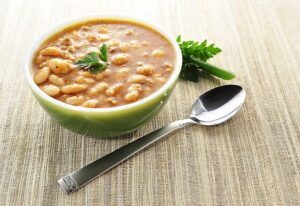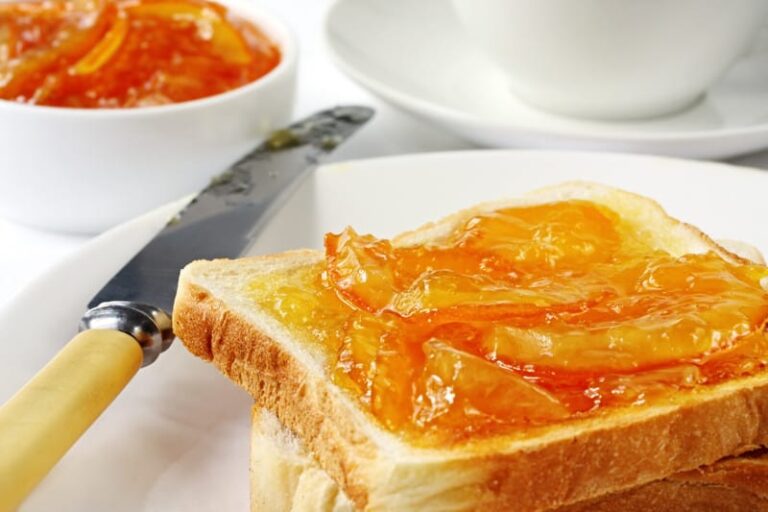How to Make Dried Bean Soup With No Recipe

Dried bean soups are hearty and perfect for chilly days. Black beans, navy beans, kidney beans, lima beans may be used. For a velvety, smooth soup, purée or whir the beans in a blender after cooking; for a soup with texture, purée only half the beans.
Water is the common liquid ingredient for dried bean soups, but for savor use white stock made with veal (from pasture-raised calves) or the liquid from water-cooked meats such as ham hocks or tongue.
Dried beans slow cooked with aromatic vegetables and herbs, spices, or seeds will literally soak up those flavors. Chunks of beef, pork, or lamb can be added to cooking dried beans, too, to make the soup extra savory.
Ratio: The basic ratio for dried bean soups is 2 part dried beans (or any dried vegetable) to 3 to 4 parts liquid. For example, 2 cups of dried beans (about 1 pound) added to 4 cups cold water or white stock.
For flavor and savor after the preliminary cooking of the dried beans, add 1 part sautéed aromatic vegetables—carrots, celery, and onions, 1 to 2 parts meat cut into cubes, and season with salt and herbs to taste.
Ratio cooked: 1 pound dried beans = 2 cups dried beans = 6 cups cooked beans. This will make about 10 servings.
Dried Beans for Soups:
Use white stock with dried beans for the best flavor.
- Black/turtle: large black beans with light creamy interior; sweet flavor.
- Cannellini/Italian kidney: medium-size white, kidney-shaped beans; nutty flavor.
- Cranberry: small, round beans with maroon markings; nutty flavor.
- Fava/broad bean: large, flat, oval tan bean.
- Garbanzo/chickpeas: medium, acorn-shaped bean; nutty flavor.
- Great Northern: large, slightly round white bean; delicate flavor.
- Kidney: medium-sized, kidney-shaped, pink to maroon beans; full-bodied flavor.
- Lima/butter: medium, slightly kidney-shaped, white to pale green bean; buttery flavor.
- Navy/Yankee: small, round, white bean.
- Pinto/red Mexican: medium, kidney-shaped, beige to brown streaked bean.
- Heirloom varieties (Calypso, Tongues of Fire, Jacob’s Cattle, Madeira): a broad range in size and color, some with stripes, some with speckles.
Preliminary Soaking of Beans:
Dried beans are dry and hard so they must be rehydrated—that is they must absorb water—to be made edible. Soak dried beans in liquid overnight (long soak) or use the short soak method before cooking dried beans.
Follow these steps to prepare dried beans for cooking:
- Spread out the dried beans on a tray or in a wide pot and remove any shell fragments, small stones, or other foreign particles then rinse well.
- Place the dried beans in a large pot and cover them with 3 times their volume in cold water to soak and rehydrate. Make sure no beans poke above the surface. Dried beans must evenly soak or they will not cook at the same rate.
- Add two or three pinches of salt to the liquid. Salt will slow the rate at which beans absorb water and become soft, but beans pre-soaked in salted water will cook faster and be more flavorful.
Long soak method: Let the beans soak in the refrigerator for 4 hours to overnight.
Short soak method: Cover the beans with 2 inches of water; bring the water to a simmer for two minutes; remove the pot from direct heat and cover; let the beans steep for 1 hour.
Drain after soaking and use fresh cold water for cooking.
Soaking dried beans leaches indigestible complex sugars that cause flatulence from the beans into the water, and soaking also leaches some nutrients, flavor, and color from beans. When soaking water is used as cooking water, nutrients, flavor and color are retained but so are the sugars that cause flatulence.
Making Dried Bean Soup:
Add stock or water to beans. Place the pre-soaked beans in wide, heavy nonreactive pot, a pot wide enough that the beans will be easy to stir. Add enough white stock or water or cooking liquid to cover the beans by at least 2 inches. Make sure the liquid covers the beans throughout the cooking time.
Boil then simmer. Bring the beans and liquid to a boil and then immediately reduce the heat to a simmer. Cook the beans at a simmer. Boiling beans usually results in uneven coking—some beans will disintegrate in the turbulence of boiling water and the seed coat of others will stay tough and never become tender.
Simmer the beans until they become evenly tender stirring occasionally to prevent beans from settling on the bottom and scorching. Simmering time will depend upon the amount of beans—simmering a large pot of beans will take 2 to 3 hours.
Check the level of cooking liquid and add more as necessary to keep the beans covered. To preserve the color of black and red beans minimize the amount of cooking liquid which draw pigments out of the seed coats; but keep the beans covered. Skim off any foam or impurities that rise to the top of the cooking liquid.
Cook until beans are tender. Check the texture of the beans for doneness as you go. A bean well-cooked is soft and creamy in texture but still retains its shape; it is not hard or grainy. A well-cooked bean should be soft and easy to mash with a fork or spoon.
When the beans are cooked tender, turn off the heat and allow the beans to cool in their liquid. If you drain the liquid away from hot beans their skins will crack
Adding Flavor to Beans:
Beans develop flavor as they cook, but the flavor is subtle. You can boost the flavor of cooked beans by adding aromatic root vegetables, herbs and spices, or meat to the pot near the end of cooking—the last 10 to 30 minutes. The flavor of the vegetables, herbs, and meat is infused in the water and in turn drawn into the bean.
(As a bean cooks liquid seeps into the bean through its hilum—the tiny white spot on its side where it was once connected to the pod. Starch granules inside the bean swell with the liquid; warm water enters the bean more quickly than cool water. Finally, the granules burst altering the texture and flavor of the bean; beans become less starchy and gain a rounder flavor and smoother texture. When vegetables, herbs, or meat are cooked in liquid with beans their soluble flavor compounds dissolve in the liquid. The liquid enters the swelling bean and flavors it. A bean that has fully swollen and can no longer absorb liquid cannot absorb any flavored liquid. Thus to add flavor to beans, you must add aromatic vegetables, herbs, or meat to the liquid before the beans are fully cooked.)
Here are several flavoring options to add near the end of cooking dried beans:
- Sauté separately diced aromatic vegetables—onions, celery, carrots, leeks, celery root, parsnip, garlic–in olive oil until just soft then stir them into the bean pot with about 10 minutes left to cook then let the mix sit for a few minutes to allow the flavors to meld.
- At the end of cooking, stir in salt and pepper to taste, add bouquet garni–a few thyme sprigs, parsley stems, and two bay leaves tied in kitchen twine–to soak.
- Add a ham hock or prosciutto bone to cook with the beans slowly (add these sooner rather than later in the cooking process for a deep meaty flavor; you can even add these at the outset of cooking). Diced bacon or ham steak added to the liquid will also deliver flavor to the beans as will chunks of beef, pork, or lamb.
- Add near the end of cooking peeled and seeded tomatoes and pasta pre-boiled for 7 to 8 minutes in lightly salted water and rinsed.
Allow at least 10 minutes of cooking beans with flavorings for the flavors to infuse.
How to Thicken Bean Soup:
When the beans have softened throughout, the soup is ready to serve as it, but you can also thicken the soup by transferring a cup or two or more of the beans and broth to a blender and purée thoroughly. Then return the purée to the cooking pot.
The soup also can be thickened by removing half of the beans to a bowl where they can be mashed by hand with a fork or potato masher then returned to the broth, or some of the beans can be mashed right in the soup pot.
The creamy liquid of a hand or blender purée will nicely suspended a mixture of whole and broken beans in the soup. For a smooth soup puree or whir all the beans in a blender after cooking; for a soup with texture, puree only half of the beans.
Acid, sugar, and calcium will slow the softening of beans and keep them firm during cooking. Tomatoes, wine, fruit juices, and vinegar are acidic. Molasses—as used in Boston baked beans–contains sugar and calcium. These can be added to the cooking beans near the end of cooking.
Serving Bean Soup:
To serve, remove the herbs, heat the soup thoroughly, and it dish up into warm bowls.
Sprinkle Parmesan cheese and a dash of extra virgin oil over each portion at the table or add a tablespoon of dry wine to each cup or bowl. Bean soup also can also be enriched with a dollop of cream or enlivened with a squeeze of fresh lemon juice and a parsley leaf or two.







